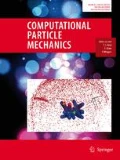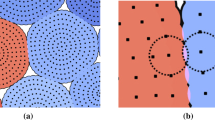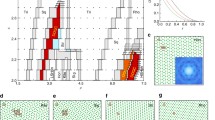Abstract
We discuss the relevance of the lattice Boltzmann method (LBM) for soft matter alongside other simulation methods. We set up a popular problem of self-assembly of Janus spheres by combining native fluid and particle models in LBM with a simple amphiphilic pair potential. Thermal fluctuations and close contact corrections are also incorporated along with a novel periodic boundary condition for finite-sized 3D particles. Preliminary results of Janus sphere self-assembly are presented and compared with similar works in the literature. We also comment on the difficulties that LBM faces tackling such problems.












Similar content being viewed by others
Availability of data and materials
All authors make sure that all data and materials as well as software application or custom code support their published claims and comply with field standards.
Code availability
Custom Fortran code.
References
Jones RA (2002) Soft condensed matter, vol 6. Oxford University Press, Oxford
Dünweg B, Ladd AJ (2009) Lattice Boltzmann simulations of soft matter systems. In: Advanced computer simulation approaches for soft matter sciences III. Springer, pp 89–166
Metropolis N, Ulam S (1949) The Monte Carlo method. J Am Stat Assoc 44(247):335–341
Zeng Q, Yu A, Lu G (2008) Multiscale modeling and simulation of polymer nanocomposites. Prog Polym Sci 33(2):191–269
Ermak DL, McCammon JA (1978) Brownian dynamics with hydrodynamic interactions. J Chem Phys 69(4):1352–1360
De Corato M, Slot J, Hütter M, D’Avino G, Maffettone PL, Hulsen MA (2016) Finite element formulation of fluctuating hydrodynamics for fluids filled with rigid particles using boundary fitted meshes. J Comput Phys 316:632–651
Hoogerbrugge P, Koelman J (1992) Simulating microscopic hydrodynamic phenomena with dissipative particle dynamics. EPL (Europhys Lett) 19(3):155
Malevanets A, Kapral R (1999) Mesoscopic model for solvent dynamics. J Chem Phys 110(17):8605–8613
Landau LD, Lifshitz EM (1959) Fluid mechanics. Course of theoretical physics. Pergamon Press, Oxford
Atzberger PJ (2011) Stochastic Eulerian Lagrangian methods for fluid-structure interactions with thermal fluctuations. J Comput Phys 230(8):2821–2837
Sharma N, Patankar NA (2004) Direct numerical simulation of the Brownian motion of particles by using fluctuating hydrodynamic equations. J Comput Phys 201(2):466–486
Patankar NA (2002) Direct numerical simulation of moving charged, flexible bodies with thermal fluctuations. In: Technical proceedings of the 2002 international conference on computational nanoscience and nanotechnology, nano science and technology institute, vol 2, pp 93–96
Serrano M, Espanol P (2001) Thermodynamically consistent mesoscopic fluid particle model. Phys Rev E 64(4):046,115
Espanol P, Revenga M (2003) Smoothed dissipative particle dynamics. Phys Rev E 67(2):026,705
Frisch U, Hasslacher B, Pomeau Y (1986) Lattice-gas automata for the Navier–Stokes equation. Phys Rev Lett 56(14):1505
Espanol P, Warren PB (2017) Perspective: dissipative particle dynamics. J Chem Phys 146(15):150,901
Krüger T, Kusumaatmaja H, Kuzmin A, Shardt O, Silva G, Viggen E (2016) The lattice Boltzmann method: principles and practice. Graduate texts in physics. Springer, Berlin
Rosenthal G, Gubbins KE, Klapp SH (2012) Self-assembly of model amphiphilic Janus particles. J Chem Phys 136(17):174,901
Rosenthal G, Klapp SH (2012) Micelle and bilayer formation of amphiphilic Janus particles in a slit-pore. Int J Mol Sci 13(8):9431–9446
Chen Q, Whitmer JK, Jiang S, Bae SC, Luijten E, Granick S (2011) Supracolloidal reaction kinetics of Janus spheres. Science 331(6014):199–202
Hong L, Cacciuto A, Luijten E, Granick S (2008) Clusters of amphiphilic colloidal spheres. Langmuir 24(3):621–625
Sciortino F, Giacometti A, Pastore G (2009) Phase diagram of Janus particles. Phys Rev Lett 103(23):237,801
Erdmann T, Kröger M, Hess S (2003) Phase behavior and structure of Janus fluids. Phys Rev E 67(4):041,209
Kobayashi Y, Arai N (2015) Self-assembly of Janus nanoparticles with a hydrophobic hemisphere in nanotubes. Soft Matter 12(2):378–385
Kobayashi Y, Arai N (2017) Self-assembly and viscosity behavior of Janus nanoparticles in nanotube flow. Langmuir 33(3):736–743
Arai N, Yasuoka K, Zeng XC (2012) Nanochannel with uniform and Janus surfaces: shear thinning and thickening in surfactant solution. Langmuir 28(5):2866–2872
Bianchi E, Panagiotopoulos AZ, Nikoubashman A (2015) Self-assembly of Janus particles under shear. Soft Matter 11(19):3767–3771
Kobayashi Y, Arai N, Nikoubashman A (2020) Structure and dynamics of amphiphilic Janus spheres and spherocylinders under shear. Soft Matter 16:476–486
Rosenthal G, Klapp SH (2011) Ordering of amphiphilic Janus particles at planar walls: a density functional study. J Chem Phys 134(15):154,707
Alarcon F, Navarro-Argemí E, Valeriani C, Pagonabarraga I (2019) Orientational order and morphology of clusters of self-assembled Janus swimmers. Phys Rev E 99(6):062,602
Shen Z, Würger A, Lintuvuori JS (2019) Hydrodynamic self-assembly of active colloids: chiral spinners and dynamic crystals. Soft Matter 15(7):1508–1521
Ladd AJ (1994) Numerical simulations of particulate suspensions via a discretized Boltzmann equation. Part 1. Theoretical foundation. J Fluid Mech 271:285–309
Galindo-Torres S (2013) A coupled discrete element lattice Boltzmann method for the simulation of fluid-solid interaction with particles of general shapes. Comput Methods Appl Mech Eng 265:107–119
Xie Q, Günther F, Harting J (2016) Mesoscale simulations of anisotropic particles at fluid-fluid interfaces. In: High performance computing in science and engineering’ 15. Springer, Berlin, pp 565–577
Bhatnagar PL, Gross EP, Krook M (1954) A model for collision processes in gases. I. Small amplitude processes in charged and neutral one-component systems. Phys Rev 94(3):511
d’Humieres D (1992) Generalized lattice-Boltzmann equations. Rarefied gas dynamics
Chun B, Ladd A (2007) Interpolated boundary condition for lattice Boltzmann simulations of flows in narrow gaps. Phys Rev E 75(6):066,705
d’Humieres D (2002) Multiple-relaxation-time lattice Boltzmann models in three dimensions. Philos Trans R Soc Lond Ser A Math Phys Eng Sci 360(1792):437–451
Schiller UD (2008) Thermal fluctuations and boundary conditions in the lattice Boltzmann method. PhD thesis, Johannes Gutenberg Universität Mainz
Adhikari R, Stratford K, Cates M, Wagner A (2005) Fluctuating lattice Boltzmann. EPL (Europhys Lett) 71(3):473
Aidun CK, Lu Y (1995) Lattice Boltzmann simulation of solid particles suspended in fluid. J Stat Phys 81(1–2):49–61
Ladd A, Verberg R (2001) Lattice-Boltzmann simulations of particle-fluid suspensions. J Stat Phys 104(5–6):1191–1251
Wang M, Feng Y, Wang Y, Zhao T (2017) Periodic boundary conditions of discrete element method-lattice Boltzmann method for fluid-particle coupling. Granul Matter 19(3):43
Ding EJ, Aidun CK (2003) Extension of the lattice-Boltzmann method for direct simulation of suspended particles near contact. J Stat Phys 112(3–4):685–708
Nguyen NQ, Ladd A (2002) Lubrication corrections for lattice-Boltzmann simulations of particle suspensions. Phys Rev E 66(4):046,708
Aidun CK, Clausen JR (2010) Lattice-Boltzmann method for complex flows. Annu Rev Fluid Mech 42:439–472
Rosenthal G (2012) Theory and computer simulations of amphiphilic Janus particles. PhD thesis, Technical University of Berlin
Frenkel D, Smit B (2001) Understanding molecular simulation: from algorithms to applications, vol 1. Elsevier, Amsterdam
Murray R, Li Z, Sastry S, Sastry S (1994) A mathematical introduction to robotic manipulation. Taylor & Francis, Milton Park
Pathria R, Beale P (1996) Statistical mechanics. Butterworth-Heinemann, Oxford
Allen M, Tildesley D (1989) Computer simulation of liquids. Oxford Science Publ, Clarendon Press, Oxford
Feng ZG, Michaelides EE (2004) The immersed boundary-lattice Boltzmann method for solving fluid-particles interaction problems. J Comput Phys 195(2):602–628
Funding
Not applicable.
Author information
Authors and Affiliations
Corresponding author
Ethics declarations
Conflict of interest
On behalf of all authors, the corresponding author states that there is no conflict of interest.
Additional information
Publisher's Note
Springer Nature remains neutral with regard to jurisdictional claims in published maps and institutional affiliations.
Supplementary Information
Below is the link to the electronic supplementary material.
Supplementary material 1 (mp4 1085 KB)
Rights and permissions
About this article
Cite this article
Nath, G., Ray, B. & Sarkar, J. Self-assembly of amphiphilic Janus spheres using the lattice Boltzmann method. Comp. Part. Mech. 9, 67–83 (2022). https://doi.org/10.1007/s40571-021-00394-1
Received:
Revised:
Accepted:
Published:
Issue Date:
DOI: https://doi.org/10.1007/s40571-021-00394-1




